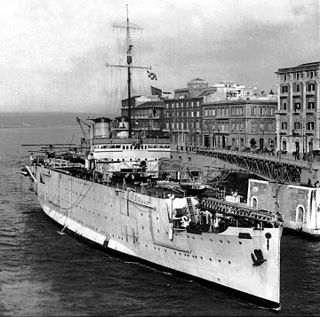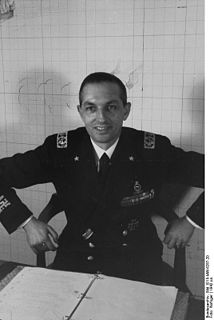Related Research Articles

The Decima Flottiglia MAS was an Italian flotilla, with commando frogman unit, of the Regia Marina created during the Fascist regime.

Luigi Durand de la Penne was an Italian Navy admiral who served as naval diver in the Decima MAS during World War II. De la Penne was born in Genoa, where he also died.

Inigo Campioni was an Italian naval officer during most of the first half of the 20th century. He served in four wars, and is best known as an admiral in the Italian Royal Navy during World War II. He was later executed by the Italian Social Republic for refusing to collaborate.

Francesco Mimbelli was an Italian naval officer who fought in World War II.

Teseo Tesei was an Italian naval officer, who invented the human torpedo used by the Regia Marina during World War II.

Giuseppe Miraglia was an Italian seaplane carrier.

The Attack on Convoy AN 14 was a naval engagement during the Second World War between a British naval force defending a convoy of merchant ships, sailing from Port Said and Alexandria to Piraeus in Greece and two Italian torpedo boats who intercepted them north of the island of Crete on 31 January 1941. The Italian vessels, Lupo and Libra launched two torpedoes each. The torpedoes fired by Libra missed their target but one from Lupo hit the 8,120 GRT British tanker Desmoulea which had to be towed to Suda Bay in Crete and beached; the ship was disabled for the rest of the war. One other merchant ship turned back; the other eight vessels reached Piraeus.

Romolo Polacchini was an Italian admiral during World War II.

Mario Marino was an Italian sailor of the Regia Marina during World War Two. As a diver and human-torpedo operator with the Decima Flottiglia MAS, he won the Gold Medal of Military Valour for the Raid on Alexandria on 19 December 1941. A 97-ton submarine-support speedboat of the Italian Navy launched in 1984 is named after him.

Mario Arillo was an Italian naval officer during World War II.

Bruto Brivonesi was an Italian admiral during World War II.
Francesco Maugeri was an Italian admiral, head of the Servizio Informazioni Segrete during World War II and Chief of Staff of the Marina Militare between 1947 and 1948.
Carlo Daviso di Charvensod was an Italian admiral during World War II, commander-in-chief of Italian naval forces in the Dodecanese from October 1941 to September 1943.

Giotto Maraghini was an Italian admiral during World War II.
Alberto Marenco di Moriondo was an Italian admiral during World War II.
Corso Pecori Giraldi was an Italian admiral. He commanded Italian naval forces in Greece and later the battleship Vittorio Veneto during World War II, and after the war he became Chief of Staff of the Italian Navy from 1955 to 1962.
Pietro Barone was an Italian admiral during World War II. He was the naval commander of Sicily for most of the war.
Salvatore Bruno Todaro was an Italian naval officer and submariner during World War II. He is best known for his participation in the battle of the Atlantic and the two instances in which he towed to safety the lifeboats carrying the survivors of ships he had sunk.
Primo Longobardo was an Italian naval officer and submariner during World War II.
Barletta was an Italian cargo liner built during the 1930s and later became an auxiliary cruiser of the Regia Marina during World War II.
References
- ↑ "Home". www.martellotta.gov.it. Archived from the original on 2012-10-01.
- ↑ "Marina Militare". www.marina.difesa.it. Archived from the original on 2011-09-27.
- ↑ "Marina Militare". www.marina.difesa.it. Archived from the original on 2011-07-07.